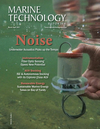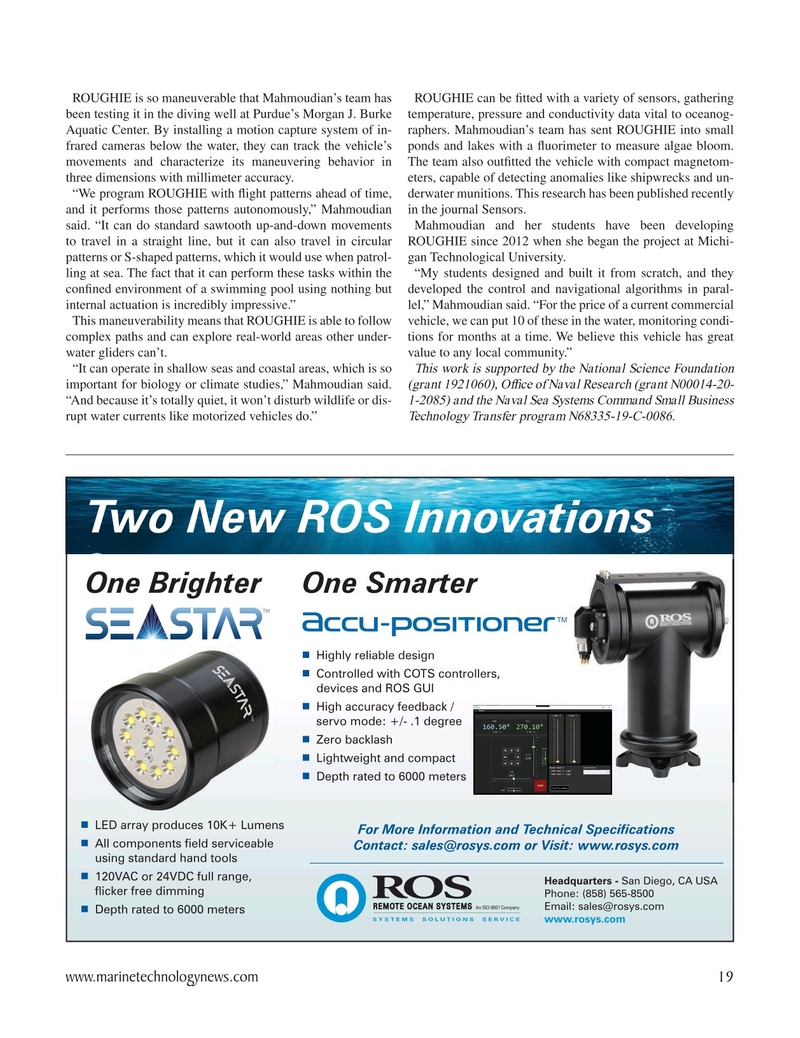
Page 19: of Marine Technology Magazine (March 2021)
Oceanographic Instrumentation & Sensors
Read this page in Pdf, Flash or Html5 edition of March 2021 Marine Technology Magazine
ROUGHIE is so maneuverable that Mahmoudian’s team has ROUGHIE can be ? tted with a variety of sensors, gathering been testing it in the diving well at Purdue’s Morgan J. Burke temperature, pressure and conductivity data vital to oceanog-
Aquatic Center. By installing a motion capture system of in- raphers. Mahmoudian’s team has sent ROUGHIE into small frared cameras below the water, they can track the vehicle’s ponds and lakes with a ? uorimeter to measure algae bloom. movements and characterize its maneuvering behavior in The team also out? tted the vehicle with compact magnetom- three dimensions with millimeter accuracy. eters, capable of detecting anomalies like shipwrecks and un- “We program ROUGHIE with ? ight patterns ahead of time, derwater munitions. This research has been published recently and it performs those patterns autonomously,” Mahmoudian in the journal Sensors.
said. “It can do standard sawtooth up-and-down movements Mahmoudian and her students have been developing to travel in a straight line, but it can also travel in circular ROUGHIE since 2012 when she began the project at Michi- patterns or S-shaped patterns, which it would use when patrol- gan Technological University.
ling at sea. The fact that it can perform these tasks within the “My students designed and built it from scratch, and they con? ned environment of a swimming pool using nothing but developed the control and navigational algorithms in paral- internal actuation is incredibly impressive.” lel,” Mahmoudian said. “For the price of a current commercial
This maneuverability means that ROUGHIE is able to follow vehicle, we can put 10 of these in the water, monitoring condi- complex paths and can explore real-world areas other under- tions for months at a time. We believe this vehicle has great water gliders can’t. value to any local community.” “It can operate in shallow seas and coastal areas, which is so This work is supported by the National Science Foundation important for biology or climate studies,” Mahmoudian said. (grant 1921060), Of? ce of Naval Research (grant N00014-20- “And because it’s totally quiet, it won’t disturb wildlife or dis- 1-2085) and the Naval Sea Systems Command Small Business rupt water currents like motorized vehicles do.” Technology Transfer program N68335-19-C-0086.
7ZR1HZ526,QQRYDWLRQV 2QH%ULJKWHU2QH6PDUWHU
Q +LJKO\UHOLDEOHGHVLJQ
Q &RQWUROOHGZLWK&276FRQWUROOHUV
GHYLFHVDQG526*8,
Q +LJKDFFXUDF\IHHGEDFN
VHUYRPRGHGHJUHH
Q =HUREDFNODVK
Q /LJKWZHLJKWDQGFRPSDFW
Q 'HSWKUDWHGWRPHWHUV
Q /('DUUD\SURGXFHV./XPHQV )RU0RUH,QIRUPDWLRQDQG7HFKQLFDO6SHFLILFDWLRQV
Q $OOFRPSRQHQWVILHOGVHUYLFHDEOH &RQWDFWVDOHV#URV\VFRPRU9LVLWZZZURV\VFRP
XVLQJVWDQGDUGKDQGWRROV
Q 9$&RU9'&IXOOUDQJH +HDGTXDUWHUV6DQ'LHJR&$86$
IOLFNHUIUHHGLPPLQJ 3KRQH (PDLOVDOHV#URV\VFRP
Q 'HSWKUDWHGWRPHWHUV
ZZZURV\VFRP www.marinetechnologynews.com 19
MTR #3 (18-33).indd 19 3/22/2021 6:43:58 PM

 18
18

 20
20
